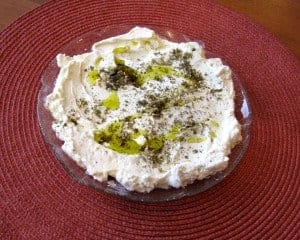 Proust had his madeleines. For me, opening a container of za’atar releases an aroma that sparks memories of strolling through the shuk, the golden light caresssing ancient stone walls. The scent also stimulates my appetite for fresh-from-the-oven pita, warm, soft and chewy, with a salty and piquant tang.
Proust had his madeleines. For me, opening a container of za’atar releases an aroma that sparks memories of strolling through the shuk, the golden light caresssing ancient stone walls. The scent also stimulates my appetite for fresh-from-the-oven pita, warm, soft and chewy, with a salty and piquant tang.
The za’atar that we know from its association with labneh and hummus on mezze plates is a condiment made from a mix of spices, herbs, and seeds, and the recipe varies from place to place.
But in fact, the name za’atar also applies to a family of related herbs that grow in the Middle East: oregano, savory, marjoram, thyme. I think it most closely resembles oregano, at least the bush that grows in my garden.
It’s really easy to mix your own za’atar if you can’t get it locally, or if you simply love the idea of making something from scratch. Just mix the following ingredients together:
- 1/4 cup sumac
- 2 tablespoons thyme
- 1 tablespoon roasted sesame seeds
- 2 tablespoons marjoram
- 2 tablespoons oregano
- 1 teaspoon coarse salt
 Rhubarb season is here, and with it comes all sorts of childhood memories. A big patch in back of our next-door neighbors’ garage was a treasure we looked forward to every year. We kids would snap off stalks to chomp on, the intense sour seemingly not a problem for us as we sat in a circle telling ghost stories into the dark on balmy summer evenings. It may even have enhanced the spooky atmosphere.
Rhubarb season is here, and with it comes all sorts of childhood memories. A big patch in back of our next-door neighbors’ garage was a treasure we looked forward to every year. We kids would snap off stalks to chomp on, the intense sour seemingly not a problem for us as we sat in a circle telling ghost stories into the dark on balmy summer evenings. It may even have enhanced the spooky atmosphere.
 Although I had a boyfriend of Iraqi-Kurdish descent when I was young, and spent a fair amount of time at his family’s home, I had never heard of, much less eaten, a sabich. But on a recent visit to Israel I was introduced to this iconic sandwich made with fried eggplant, tehina, hummus, hardboiled egg, Israeli salad, pickles, sometimes a potato, and pickled mango sauce called amba– all stuffed into a pita or rolled into laffa. What was once a traditional Saturday morning breakfast for Iraqi Jews has become an Israeli street food almost as popular as falafel.
Although I had a boyfriend of Iraqi-Kurdish descent when I was young, and spent a fair amount of time at his family’s home, I had never heard of, much less eaten, a sabich. But on a recent visit to Israel I was introduced to this iconic sandwich made with fried eggplant, tehina, hummus, hardboiled egg, Israeli salad, pickles, sometimes a potato, and pickled mango sauce called amba– all stuffed into a pita or rolled into laffa. What was once a traditional Saturday morning breakfast for Iraqi Jews has become an Israeli street food almost as popular as falafel. 